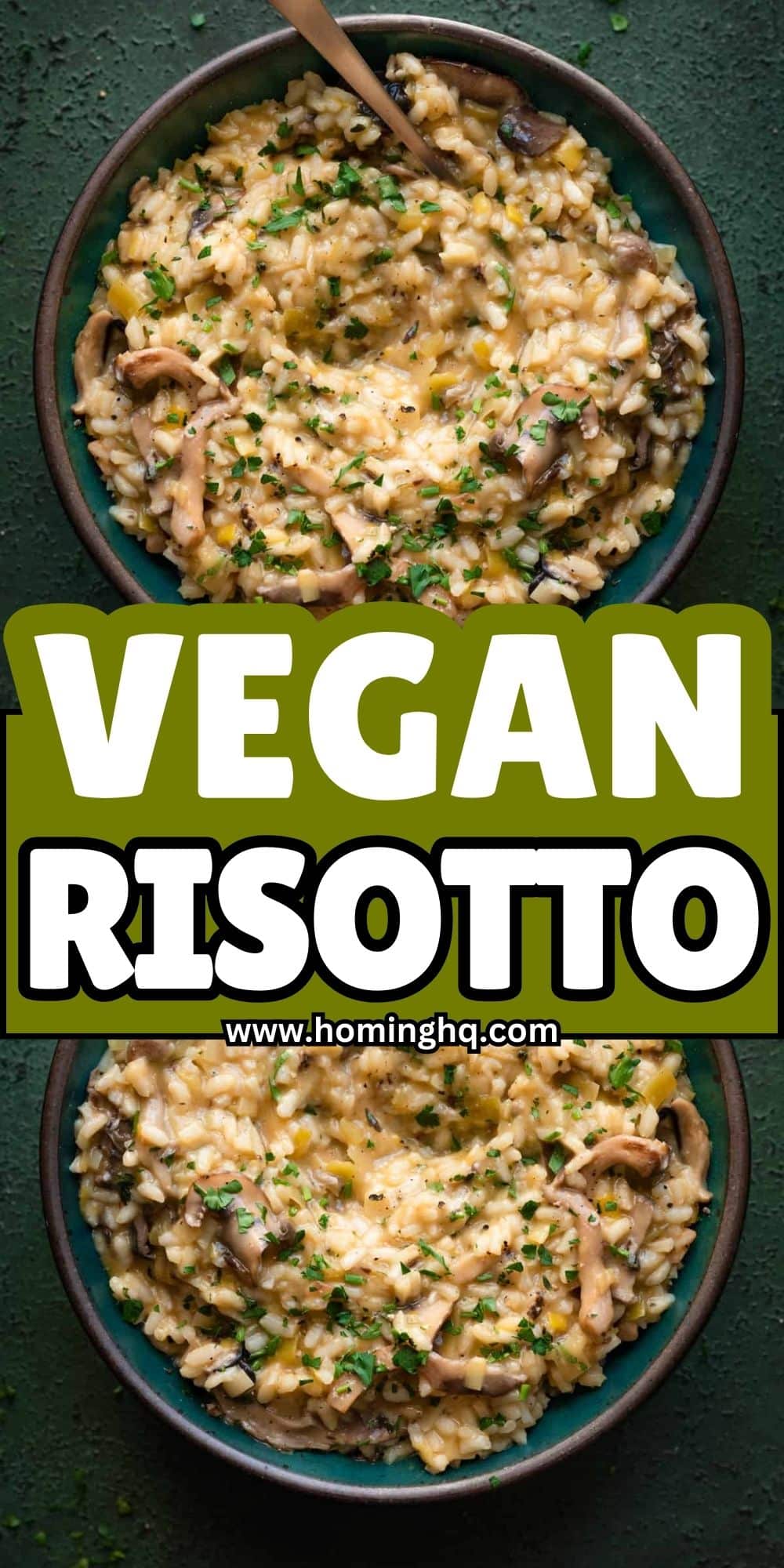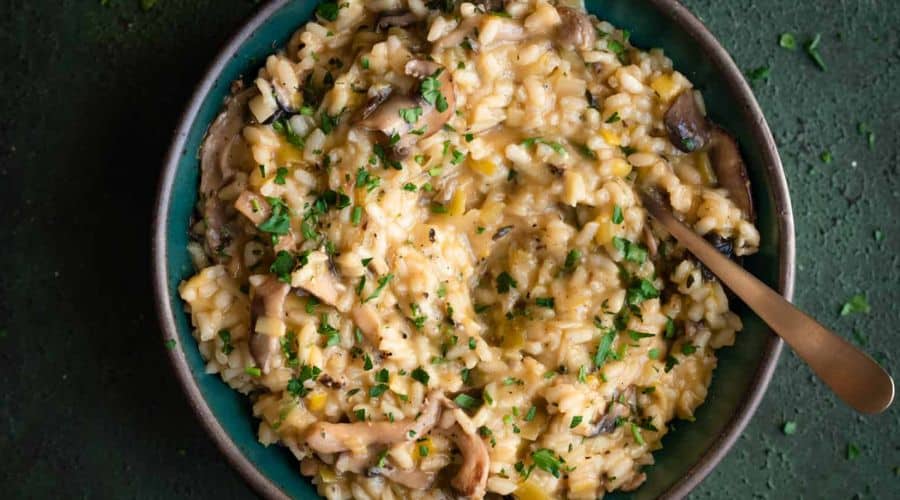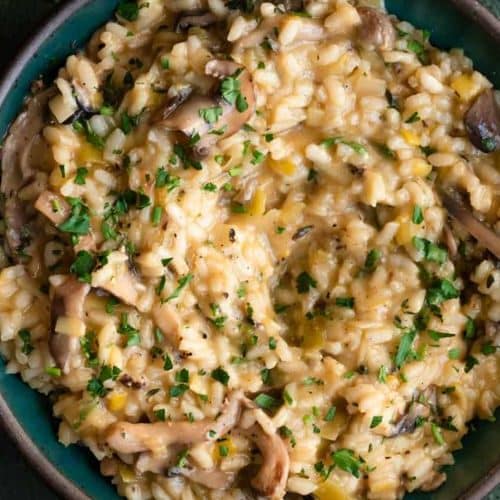All products are selected by our editorial team for quality. If you buy through our links, we may earn a small commission at no extra cost to you.
Vegan risotto is the perfect blend of comfort and elegance, offering a rich, creamy texture without the need for dairy.
Traditional risotto relies on butter, cheese, and sometimes cream, but this plant-based version achieves the same indulgent consistency using wholesome, natural ingredients.
Whether you’re looking for a hearty weeknight meal or a dish to impress guests, vegan risotto is a versatile option that can be customized with different vegetables, herbs, and spices.
From earthy mushrooms to vibrant asparagus or even roasted butternut squash, the possibilities are endless.
With the right technique and a few key ingredients, you can create a restaurant-quality risotto at home—no dairy required.
This guide will take you through everything you need to know, from selecting the best rice to mastering the art of gradual broth absorption for that signature velvety finish.

Why You’ll Love This Vegan Risotto
Creamy and Luxurious Without Dairy
The natural starch from Arborio rice creates a luscious, creamy texture, making this risotto just as satisfying as traditional versions.
A touch of dairy-free butter or nutritional yeast enhances the richness without overpowering the dish.
Easy to Customize with Seasonal Ingredients
Vegan risotto is incredibly adaptable to different flavors and ingredients.
You can make it with mushrooms for an earthy depth, asparagus and lemon for a bright springtime dish, or pumpkin and sage for a cozy autumn meal.
Wholesome and Nutritious
Unlike traditional risotto, which can be heavy with butter and cheese, this plant-based version is lighter yet still packed with nutrients.
Vegetables, herbs, and plant-based proteins make it a well-balanced meal that’s both delicious and nourishing.
Simple Cooking Process with Gourmet Results
While risotto has a reputation for being labor-intensive, it’s actually quite simple when you follow the right technique.
By gradually adding warm broth and stirring occasionally, you’ll achieve the perfect creamy consistency without the need for cream or cheese.
Essential Ingredients for Vegan Risotto
Arborio Rice – The Key to Creaminess
Arborio rice is the best choice for risotto due to its high starch content, which creates a naturally creamy texture.
If unavailable, Carnaroli or Vialone Nano are excellent alternatives.
Vegetable Broth – The Base of Flavor
Using a rich, homemade vegetable broth elevates the risotto’s taste.
Store-bought broth works well too, but opt for a low-sodium version to control the seasoning.
Onions and Garlic – Essential Aromatics
A good risotto starts with sautéed onions and garlic, adding depth and a savory foundation to the dish.
Shallots can be used as a milder alternative.
Dry White Wine (Optional) – Adds Complexity
A splash of dry white wine enhances the risotto’s flavor with a subtle acidity.
If you prefer to skip it, simply substitute it with extra broth and a squeeze of lemon juice.
Dairy-Free Butter or Olive Oil – For a Rich Finish
A small amount of vegan butter or high-quality olive oil stirred in at the end gives the risotto a silky, luxurious texture.
Nutritional Yeast or Vegan Parmesan – A Cheesy Umami Boost
Nutritional yeast adds a slightly cheesy, nutty flavor, mimicking the umami depth of traditional Parmesan.
You can also use store-bought vegan Parmesan for a similar effect.
Fresh or Roasted Vegetables – Customizable Flavor
The beauty of risotto is that it pairs well with various vegetables. Some popular options include:
- Mushrooms – Adds a deep, earthy flavor.
- Asparagus and Peas – Bright and fresh, perfect for spring.
- Butternut Squash or Pumpkin – Naturally sweet and creamy, great for fall.
- Spinach or Kale – A nutritious way to add greens.
Herbs and Seasonings – Bringing It All Together
Fresh herbs like parsley, thyme, or basil enhance the risotto’s aroma. Don’t forget a pinch of salt and black pepper to balance the flavors.
Step-by-Step Guide to Making Vegan Risotto

Step 1: Prepare the Ingredients
Gather and prep all ingredients before you start cooking. Chop the onions, mince the garlic, and prepare any vegetables you’ll be adding.
Warm the vegetable broth in a separate pot over low heat—this ensures a smoother cooking process.
Step 2: Sauté the Aromatics
In a large pan, heat a drizzle of olive oil or a small amount of vegan butter over medium heat.
Add the onions and garlic, cooking until they become soft and translucent. This forms the flavor base of the risotto.
Step 3: Toast the Rice
Add the Arborio rice to the pan, stirring continuously for 1-2 minutes until the grains become slightly translucent around the edges.
This step enhances the nutty flavor of the rice and helps it absorb liquid more evenly.
Step 4: Deglaze with White Wine (Optional)
Pour in the white wine and stir until it is mostly evaporated. This step adds a subtle acidity and enhances the depth of flavor.
If not using wine, simply skip to the next step.
Step 5: Gradually Add Warm Broth
Ladle in about ½ cup of warm vegetable broth, stirring gently and allowing the rice to absorb the liquid before adding more.
Continue this process, adding broth in small amounts and stirring occasionally.
The risotto should be creamy but not soupy.
Step 6: Incorporate Vegetables and Seasoning
Once the rice is nearly cooked (after about 18-20 minutes), add your chosen vegetables.
If using firmer vegetables like mushrooms or butternut squash, cook them separately and stir them in at this stage.
Add salt, black pepper, and nutritional yeast or vegan Parmesan for extra flavor.
Step 7: Finish with Vegan Butter for Creaminess
For a silky finish, stir in a small amount of dairy-free butter or olive oil. This enhances the risotto’s texture and adds a subtle richness.
Step 8: Serve and Garnish
Remove the risotto from heat and let it rest for a minute. Garnish with fresh herbs, a sprinkle of extra vegan Parmesan, and a drizzle of olive oil if desired.
Serve immediately while warm and creamy.
Would you like me to continue with the next sections?
Tips for the Best Vegan Risotto
Use Warm Broth for a Smooth Cooking Process
Always keep your vegetable broth warm in a separate pot while making risotto.
Adding cold broth can disrupt the cooking process and prevent the rice from absorbing liquid evenly.
Warm broth ensures a consistent texture and a creamy final result.
Stir Frequently, But Not Constantly
While risotto does require regular stirring, excessive stirring can break down the rice grains too much, leading to a gummy texture.
Stir just enough to keep the rice from sticking to the pan while allowing it to release its natural starch for creaminess.
Don’t Rush the Broth Absorption
Adding broth gradually is key to achieving the perfect consistency.
Pour in a ladleful at a time, waiting until the liquid is mostly absorbed before adding more.
This allows the rice to cook evenly and develop the signature velvety texture.
Avoid Overcooking the Rice
The ideal risotto should have a slightly firm, or “al dente,” texture. Overcooking can make it mushy.
Taste the rice frequently in the last few minutes of cooking to ensure it retains a slight bite.
Experiment with Flavors and Add-Ins
Vegan risotto is incredibly adaptable. For extra umami, try adding a splash of tamari or a teaspoon of white miso paste.
For a hint of richness, a swirl of coconut milk or cashew cream at the end can create a luxurious finish.
You can also experiment with different herbs, spices, and vegetable combinations to create a risotto that suits your taste.
Serving Suggestions
Pair with a Crisp Salad for a Balanced Meal
A fresh salad with a tangy vinaigrette balances the richness of risotto beautifully.
Try a simple arugula salad with lemon dressing or a mix of greens, cherry tomatoes, and toasted nuts for added crunch.
Serve with Roasted Vegetables for Extra Flavor
Oven-roasted vegetables like Brussels sprouts, zucchini, or bell peppers add texture and color to your meal.
The caramelized flavors of roasted veggies complement the creamy risotto perfectly.
Enjoy with a Side of Crispy Tofu or Tempeh
For a protein boost, serve your risotto with crispy pan-fried tofu or tempeh.
You can season it with garlic, smoked paprika, or soy sauce to enhance the overall flavor of the dish.
Garnish for the Perfect Finishing Touch
A sprinkle of fresh herbs, such as parsley or basil, brightens up the dish.
For an extra cheesy flavor, add a bit more nutritional yeast or vegan Parmesan.
A light drizzle of truffle oil can also elevate the dish for a more gourmet experience.
Pair with a Glass of Vegan White Wine
If you enjoy wine with your meal, a crisp, dry white wine such as Sauvignon Blanc or Pinot Grigio pairs well with risotto.
Their acidity helps balance the creaminess, making for a well-rounded dining experience.
Would you like me to continue with the next sections?
Storage & Reheating Tips
How to Store Leftover Vegan Risotto
Vegan risotto is best enjoyed fresh, but if you have leftovers, store them properly to maintain their texture and flavor.
Place the risotto in an airtight container and refrigerate it for up to 3 days. Avoid leaving it at room temperature for extended periods, as cooked rice can develop bacteria quickly.
The Best Way to Reheat Risotto
Risotto tends to thicken as it sits due to the starch in the rice. To bring back its creamy consistency, follow these steps when reheating:
- Stovetop Method (Best Option) – Place the risotto in a pan over low heat. Add a splash of vegetable broth or water and stir gently until it becomes creamy again.
- Microwave Method (Quick Option) – Transfer the risotto to a microwave-safe bowl. Stir in a little broth or water, then heat in 30-second intervals, stirring in between, until warmed through.
- Avoid High Heat – Heating risotto too quickly can make it dry or cause the rice to overcook. Always reheat on low to medium heat for the best results.
Can You Freeze Vegan Risotto?
Freezing risotto is not recommended, as the texture can become grainy and lose its creamy consistency when thawed.
However, if necessary, you can freeze it in an airtight container for up to 1 month.
When reheating, defrost it in the fridge overnight and follow the stovetop reheating method with added broth.
Conclusion
Vegan risotto proves that you don’t need dairy to create a rich, satisfying dish.
With the right ingredients and techniques, you can achieve a creamy, flavorful risotto that’s just as indulgent as the traditional version.
Whether you prefer classic mushroom risotto, a bright lemon asparagus variation, or a hearty butternut squash option, this dish is incredibly versatile and easy to customize.
By using simple plant-based ingredients like nutritional yeast, dairy-free butter, and fresh vegetables, you can elevate your risotto without sacrificing taste or texture.
Plus, with proper storage and reheating techniques, you can enjoy your risotto even after the initial serving.
Now that you have all the tools to make a perfect vegan risotto, give it a try and experiment with your favorite ingredients.
Let us know how your dish turned out in the comments, and don’t forget to share your favorite risotto variations!
Frequently Asked Questions
Can I Make Risotto Without Wine?
Yes! While white wine adds acidity and depth, you can easily skip it.
Substitute it with extra vegetable broth and a squeeze of lemon juice or a dash of apple cider vinegar for a similar effect.
What’s the Best Rice for Vegan Risotto?
Arborio rice is the most common choice due to its high starch content, which creates the signature creamy texture.
Carnaroli and Vialone Nano are excellent alternatives, offering even better consistency.
Avoid long-grain rice like basmati or jasmine, as they don’t produce the same results.
How Do I Prevent My Risotto from Becoming Mushy?
The key is to gradually add broth and stir frequently but not constantly.
Adding too much liquid at once or overcooking the rice can cause it to break down and become mushy.
Taste the rice towards the end of cooking to ensure it remains slightly firm, or “al dente.”
Can I Make Risotto in Advance?
Risotto is best enjoyed fresh, but if you need to prepare it in advance, slightly undercook the rice and stop before adding the final ladle of broth.
When ready to serve, reheat it on the stove with a little extra broth, stirring until it reaches the desired consistency.
What Are Some Unique Vegan Risotto Variations?
Vegan risotto is incredibly versatile! Here are a few creative variations:
- Mushroom & Truffle Risotto – Deep, earthy flavors with a touch of truffle oil.
- Lemon & Asparagus Risotto – A fresh, spring-inspired dish.
- Pumpkin & Sage Risotto – Perfect for fall with a naturally creamy texture.
- Spicy Tomato Risotto – A bold, tangy option with roasted tomatoes and chili flakes.
- Pesto Risotto – Stir in vegan pesto for a vibrant, herbaceous flavor.

Vegan Risotto
Equipment
- 1 Large saucepan or deep skillet
- 1 Medium pot (to warm vegetable broth)
- 1 Ladle
- 1 wooden spoon or silicone spatula
- 1 Cutting Board
- 1 Sharp knife
Ingredients
Base Ingredients
- 1 tablespoon olive oil or vegan butter
- 1 small onion finely chopped
- 2 cloves garlic minced
- 1 ½ cups Arborio rice
- ½ cup dry white wine optional, can be substituted with broth and lemon juice
- 4 cups vegetable broth warmed
Flavor Enhancers & Add-ins
- ½ teaspoon salt adjust to taste
- ¼ teaspoon black pepper
- ¼ cup nutritional yeast or vegan Parmesan
- 1 tablespoon lemon juice optional, for brightness
- 1 teaspoon fresh thyme or parsley chopped
Optional Vegetables (Choose Your Favorite)
- 1 cup mushrooms sliced
- 1 cup asparagus chopped
- 1 cup peas
- 1 cup butternut squash diced and roasted
- 1 cup spinach roughly chopped
Instructions
Step 1: Prepare the Ingredients
- Finely chop the onion and mince the garlic.
- If adding vegetables, prep them accordingly (slice mushrooms, chop asparagus, etc.).
- Warm the vegetable broth in a medium pot over low heat.
Step 2: Sauté the Aromatics
- In a large saucepan, heat olive oil or vegan butter over medium heat.
- Add the chopped onion and sauté for 2–3 minutes until soft.
- Stir in the garlic and cook for another minute until fragrant.
Step 3: Toast the Rice
- Add the Arborio rice to the pan and stir continuously for 1–2 minutes until the grains become slightly translucent around the edges.
Step 4: Deglaze with White Wine (Optional)
- Pour in the white wine and stir until mostly evaporated.
- If not using wine, skip to the next step.
Step 5: Gradually Add Warm Broth
- Add a ladleful (about ½ cup) of warm broth to the rice, stirring gently.
- Allow the rice to absorb the liquid before adding more.
- Repeat this process, stirring occasionally, until the rice is creamy and cooked to a slightly firm (al dente) texture, about 18–20 minutes.
Step 6: Incorporate Vegetables and Seasoning
- If using quick-cooking vegetables like peas or spinach, stir them in during the last few minutes of cooking.
- If using mushrooms, asparagus, or butternut squash, cook them separately and add them in now.
- Season with salt, black pepper, and nutritional yeast or vegan Parmesan.
Step 7: Finish with a Creamy Touch
- Stir in a small amount of vegan butter or a drizzle of olive oil for extra richness.
- Add a squeeze of lemon juice for brightness.
Step 8: Serve and Garnish
- Remove from heat and let the risotto rest for a minute.
- Garnish with fresh thyme or parsley.
- Serve warm and enjoy!
Notes
- Substitutions: If you don’t have Arborio rice, use Carnaroli or Vialone Nano for similar results.
- No-Oil Option: Sauté onions and garlic in vegetable broth instead of oil for an oil-free version.
- Protein Boost: Add chickpeas, white beans, or toasted nuts for extra protein.
- Leftovers: Store in an airtight container in the fridge for up to 3 days. Reheat with a splash of broth to restore creaminess.

